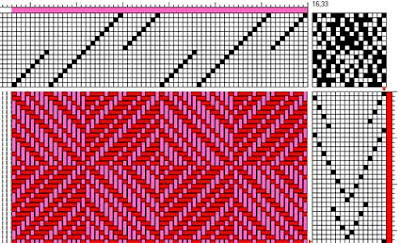Or... "a twill threading"? Combined with a "huck tie-up"? "Treadled as ..."? Sometimes I can decode the message: a "twill threading" often is what I call a "straight threading". But a "huck tie-up"? Huck is (to me, that is) a structure (of the resultant fabric) - so, a "huck tie-up" is a tie-up that will, in combination with a threading and a treadling, give me a huck fabric.
I once wove this 2-block diamond twill to see how such a pattern would react to "vadmalizing" - would the pattern still be visible, or would patterning the cloth to be fulled be meaningless? (left side loom-state, right side after "stamping")

I wanted the threading to be as easy as possible, and the treadling, too. The draft became:

Personally, I don't like "walking the treadles". However - if I had wanted to, the draft would have looked like this:

Had the yarn been very hairy, or the sett extremely close, I might have changed the threading:

More complicated to thread, but (according to some books, at least!) the spreading of the shafts to be lifted at the same time would help the forming of the shed.
The point is: the fabric is a 2-block diamond twill. The same 2-block diamond twill, even though the threading and/or tie-up and/or treadling are different. So... "a twill threading"? Or "a 2-block tie-up"?
Just for fun, I combined the above possibilities, to see what happened...
The two threadings, the two treadlings,and the two re-arranged tie-ups:


And, whatever they are, 3 out of 4 combinations can't be called 2-block diamond twill...

No comments:
Post a Comment